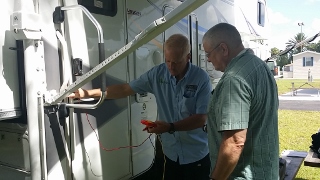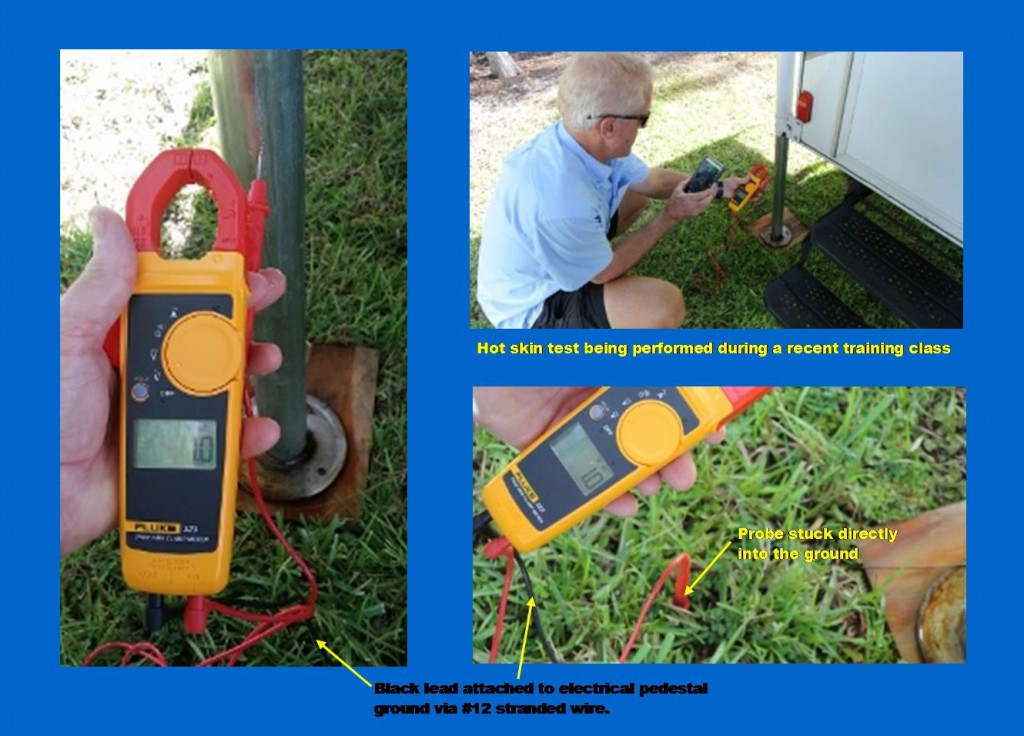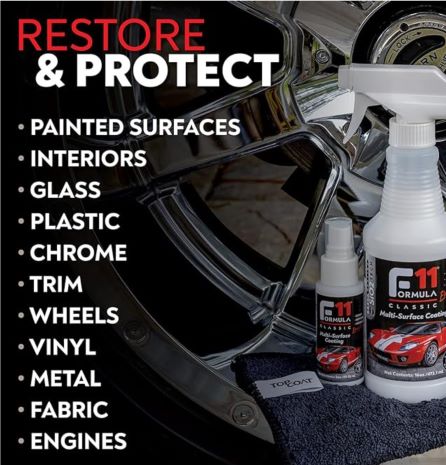There’s nothing more disheartening than hearing a story like this: a child touches an RV and is killed by electrocution! How can you die from touching an RV that is plugged into an electrical source? The condition is called RV hot skin, and I would like to share a few thoughts that might help you to identify whether this condition exists in your RV.
The story of this boy is sad and could have been avoided if someone had noticed that touching the RV gave a tingling sensation. Have you ever touched a live wire and felt that? We usually live to tell about it because we may have been wearing shoes, or were isolated from the ground in some way, and the electricity did not have a chance to travel through your body back to the ground.
Since the child was barefoot, and from what I heard, on wet grass, when he touched the RV, electricity was able to travel through the RV frame, through the boy’s body and back to the ground. Doing so was severe enough in this case to kill him. The final determination was that the RV was plugged into an improperly wired receptacle.
You may not notice this condition in an RV as it is a big metal box that makes contact with the ground via rubber tires. You can plug it in and not notice that it is electrically charged with anywhere from thirty to one hundred and twenty volts until a connection is made between a body part and the ground. Electricity is always seeking a path back to the ground. You want to be sure you are not that path!

Recent Hot Skin Test on a Truck Camper
In working at campgrounds, I have come across numerous cases of RV hot skin conditions. Since I have worked maintenance positions, we were the first folks that got called to assist guests with this tingling sensation.
Fortunately, in the cases I was involved in nobody got killed, but several folks suffered pains that lasted for days. They always assumed it was the park power that caused the issue, but it in the parks I have worked in it was always the RV that created the problem.
HOW CAN THIS HAPPEN?
Okay, what would cause this? Let’s say you bring your RV home from a trip, drain the water system but leave it plugged in to keep the battery system charged. But, what if you forget to turn off the electric water heater?
So there is your water heater without water in the tank, yet the heating element is still trying to electrically heat the water that is not there. It will not take too long for the element to burn out!
Then, the next time you decide to take your RV out, and you refill and activate the water system, the heating element is no longer a sealed component in the water tank. Now it will have the opportunity to pass electrical current through the water in the tank to the RV frame that the water heater is attached to.
So, when you get to an RV park and plug into the power pedestal, you have now energized the RV frame and all the metal components attached to it. Any time you touch a metal surface that is linked to the RV’s frame you will sense a tingling sensation depending on the amount of voltage that is passing through to the frame. I have seen voltage readings of anywhere from thirty volts on up to one hundred and twenty volts when testing for an RV hot skin.
Hot water heaters have not been the only thing I have seen energize an RV: I have seen AC units send voltage through the RV, and I have seen the Dometic and Norcold fridges also create this condition. Some RV parks can create this condition due to a reverse polarity condition in the electrical pedestal.
That is why an electrical management system is so important! Improper grounding can also create a difference in voltage potential between the RV and the earth around it. Once diagnosed I always recommend folks call a reliable RV tech to fix the problem.
The condition can also be created by wires rubbing against the frame due to vibration during travel. Once the wire insulation is worn away, and the conductor is exposed to the metal frame, current can pass through the RV along any path that may lead to ground. And it could be you!
A friend shared a story of some folks that had an RV dealership install a new 120v fixture in their RV. While doing so, the technician reversed the ground and neutral connection. Now, with that new connection made, the electricity was trying to use the RV to get back to ground instead of the intended grounding system. Once the RV owner touched, the light switch problems arose. Serious injury was avoided, but a lawsuit did arise from the situation.
The only way to be sure you don’t have electricity going to places it should not go is to test with a volt meter. You can use a volt pen, but if the voltage is below forty volts, most volt pens will not show any reading. A volt meter is best to test metal surfaces of the RV to see if the voltage is trying to get back to the ground.
Recent Case Study!
Here is an example of a recent test done on a truck camper. These types of RV’s can have a direct connection to the earth via their landing legs. These legs help to stabilize the unit once a campsite is reached.
In this particular case, we were doing a training session on hot skin testing and noticed we did have a small amount of voltage being read around the leveling legs and RV rear door. One, in particular, read the largest voltage at 1 – 1.2 volts. Now this is nothing to be too concerned about, but conditions can change, and this could turn into a problem.
Upon further investigation, it was noted that the voltage dissipated the farther we got from the rear curbside leveling leg. It was also noted that the ground was wet due to the roof AC dripping in this spot. Once the red lead of the voltmeter was placed directly into the nearby ground, instead of in contact with the leveling leg, the same voltage was observed.
So, in this case, it was not the RV that was the problem, but ground voltage was traveling up from the wet area, through the wet plywood the owner had placed below the landing leg’s base, through the metal frame and to the rest of the RV. Once ground contact was removed from the leveling leg, the voltage reading was zero.
Plywood is not the best thing to use in this case! When wet it becomes a conductor! RV supply stores sell the heavy duty plastic pieces that are designed for just this application. My concern here for the owner, in this scenario, would be in a thunderstorm. What if a bolt of lightening struck an object near the RV? This could have been a bad situation!
HOW CAN YOU SOLVE THE PROBLEM?
Once you have tested your RV and found this condition, it is easy to isolate the problematic circuit. If you turn off all breakers inside the RV, and one at a time turn each one on, you can test to see if voltage energizes the RV’s skin.
Do this for each breaker: turn it on, test for hot skin voltage, turn it off, try the next breaker till you getting a voltage reading. Do this by contacting something like the RV’s door handle with one lead of the voltmeter, and the other lead to a good ground source.
Of course, if you test your RV with all electrical sources engaged, and you have no hot skin condition, you don’t have to worry about it. But, conditions can change so always be aware that this can happen at any time. It does not matter if it’s the 12-volt system or the 120-volt system. Either can cause serious injury. It’s not the volts that kill you, but the amps. And it takes very little to affect the heart!
So, please be aware of this situation! Pay attention to your RV and what it is telling you! If you do, you will always be safe and able to continue to enjoy the RV lifestyle.
If you are uncomfortable with this whole procedure, you can call a qualified RV inspector. That person can do a complete analysis of your entire RV to determine if there are any RV safety issues that need to be addressed.
Please leave comments if you enjoyed the information and found it useful!!
Blessings,
Howard and Pam
Update – Thanks to Mike Sokol of noshockzone.org for stopping by! He placed a comment which I have moderated through so you can see his comments and make your determinations as to the content of my article.
My experience with these situations comes from years of working with many RV’s in RV parks, and the techs that wound up fixing the problems. I can only draw my conclusions from those experiences and relationships with RV technicians and trainers. Thanks again Mike! We all want to see people enjoy safe RV travels, hence my involvement in the industry. It was an unfortunate situation that drove me to share my experiences here!











3 comments
I’m the author of the No~Shock~Zone article about hot-skin testing that you obviously used for research in this article without providing proper references and credits to me and No~Shock~Zone. Also, the picture used in your article came directly from my website and is not public domain, because I drew it myself. So please provide proper credits for that. And finally, you statement about a burned out hot water heater element causing a hot skin condition is misleading. If an RV has a properly grounded and bonded EGC tied back to the service panel (Electrical Grounding Conductor and often called a safety ground) then it’s impossible for a hot-skin condition to exist. Any leakage currents from something like a burned hot water heater element or wire shorted to the frame would cause the circuit breaker to trip before any voltage could exist on the skin of the RV. And lastly, there are dual-range NCVT (Non Contact Voltage Testers) that will discover a hot-skin condition down to 5 volts. But these aren’t useful for standard outlet polarity testing, which is why I recommend a standard 90 to 1,000 volt tester. I know how this works because I’ve designed my own hot-skin inducer that can bias an RV’s chassis and skin from zero up to 150-volts AC. Yes, a DMM and a properly grounded test point are the best for troubleshooting, but since most low-current hot-skin conditions will float up to 1/2 line voltage (60 volts), then a NCVT is a useful tool for the first line of troubleshooting.
Please contact me with any questions. I want to make sure that all discussions about RV electrical safety are 100% accurate.
Mike Sokol
Author
Thanks to Mike for checking in! I have moderated his comments through to the comments section for readers consideration. As far as his claims to duplicating his content, I have no need to do that. Having worked in transient campgrounds for years, I have experienced this issue first hand. I have also helped RVers solve their problems with RV hot skin conditions. My article comes from experience in the field and interaction with RV techs in resolution of the problems. I have also had the benefit of observing some of the causes that created these issues. Now, as a certified NRVIA RV inspector I continue to help folks uncover these issues before they ever have a chance to create a situation like this.
Good story to pass on.
Thank you.